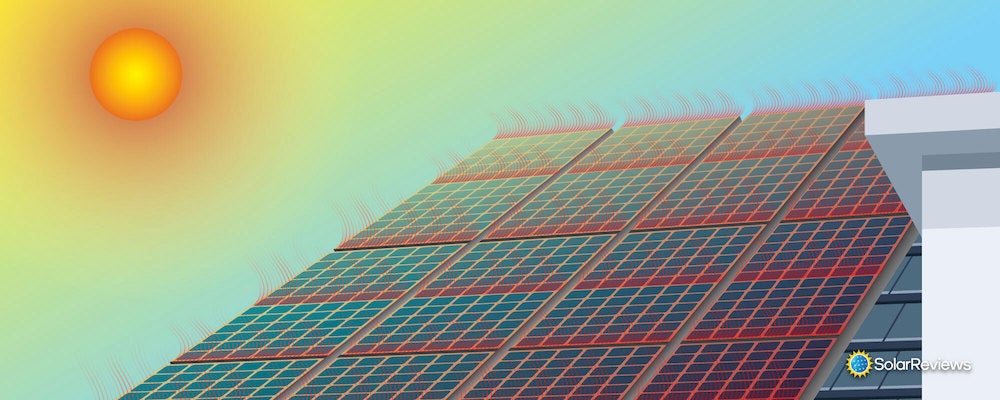
Because solar panels are made to withstand extreme temperatures, it is unlikely that solar panels will ever get so hot that they cannot function.
Heat will slightly reduce the energy output of solar PV modules, which is a measurement that can be determined by the panel’s temperature coefficient. In this article, we will discuss how temperature affects solar panel efficiency and output, and why Tier 1 solar panels are a good investment.
What is the optimal solar panel temperature?
Like any other electrical equipment, solar panels work at maximum efficiency when their temperature is as cool as possible.
To test the rated maximum output of solar panels, they are measured under the condition of 25 degrees Celsius (or 77 degrees Fahrenheit), while 1,000 watts of light per square meter shines on them.
While these Standard Test Conditions (STC) are a little unrealistic, their purpose is to make sure that your panels can produce electricity under ideal conditions. For example, most solar panels are 250-350-watt panels, so under the above testing conditions, they should be able to generate 250-350 watts of power.
Most solar panels have a rated “solar panel max temperature” of 185 degrees Fahrenheit - which seems intense. However, solar panels are hotter than the air around them because they are absorbing the sun’s heat, and because they are built to be tough, high temperatures will not degrade them.
Are solar panels hot to the touch?
Yes, solar panels are hot to the touch. Generally speaking, solar panels are 36 degrees Fahrenheit warmer than the ambient external air temperature.
When solar panels get hot, the operating cell temperature is what increases and reduces the ability for panels to generate electricity. Because the panels are a dark color, they are hotter than the external temperature because dark colors, like black, absorb more heat.
For example, the ambient temperature in the desert can reach 113 degrees Fahrenheit, meaning solar panels in this climate can reach 149 degrees Fahrenheit.
The physical panel and metal racking that secure them in place are definitely not meant to be touched on a particularly hot day.
What is the ‘temperature coefficient’?
The temperature coefficient is the percentage decrease in energy production for each increase in degree Celsius over 25, or 77 degrees Fahrenheit. A low temperature coefficient is best.
The reduction in output is minimal, only about .5%, so you will probably not notice your solar panels performing any worse.
For reference, the temperature coefficient from major solar panel manufacturers’ data sheets is below.
| Panel | Brand | Temp. Coefficient | Rated Max Output |
|---|---|---|---|
| X21-350-BLK | SunPower | -0.29%/°C | 350W |
| HIT N330 | Panasonic | -0.26%/°C | 330W |
| CS6K-300 | Canadian Solar | −0.39%/°C | 300W |
| TSM-PEG5-285 | Trina Solar | −0.41%/°C | 285W |
| Q.PEAK-G5 310 | Hanwha | −0.39%/°C | 310W |
For example, let’s say you have the Sunpower module and the solar cell temperature is measured at 45 degrees C. That’s 20 degrees C above STC. To find how much the power output will decrease, you multiple the 20 degrees C difference by the -0.29% temperature coefficient. That gives you a 5.8% drop in the module's power output.
That means when the panels’ temperature is 45 degrees C, the maximum power output of the module will fall to 329.7 watts, instead of 350 watts, meaning, your panels will still produce enough energy to power your home.
What is solar panel efficiency?
Solar panels are made up of photovoltaic cells; these cells are what converts the sun’s rays into energy. Solar panel efficiency is the percentage of light that strikes the surface of the photovoltaic cell that is then converted into energy.
Monocrystalline and polycrystalline rooftop solar panels can be made up of anywhere from 60-72 solar cells. Most reputable solar brands will have an efficiency between 15% and 20%, meaning that 15% to 22% of the sunlight that hits the panel is converted into usable electricity.
The SunPower's SPR-X21-350-BLK listed above is the highest efficiency residential solar module with a rating of 11.8% efficiency. The SPR-21-350-BLK also has the second-best temperature coefficient at an impressively low -0.29%.
Is it worth paying extra for a premium-brand panel?
Although the higher price tag might be off-putting, premium panels lose less output as temperature rises, have a higher efficiency, and come with better warranties. The industry has implemented 3 different tiers for judging solar manufacturers: Tier 1, Tier 2, and Tier 3.
Tier 1 represents the highest quality in efficiency, panel output, and warranty. Some examples of Tier 1 brands include Sunpower, Solarworld, Panasonic, LG, Trina, Jinko, ReneSola, and Canadian Solar.
Reputable installers typically use Tier 1 brands which will cost a bit more than Tier 2 or Tier 3 panels, but will perform better over their lifetimes.
Tier 1 brands have power outputs that degrade much less over time than Tier 2 or Tier 3 panels. This means more energy will be produced over the lifetime of the system, which equates to less power that needs to be purchased from the utility.
Despite the additional upfront investment, the savings over time will make up for the higher cost.
How long is a solar panel warranty?
There are two types of warranties for solar panels: product warranties and power output warranties.
Product warranties cover defects in the panel that cause it to stop working, such as a panel that breaks during a storm. These warranties typically last for 10 years.
The power output warranty is a guarantee that the panel will produce a certain percentage of its rated output, usually for a term of 25 years.
Below, we compare the warranties of Panasonic and SunPower, two major Tier 1 brands.
| Brand | Limited product warranty | Output after Year 1 | Annual degradation rate | Output after 25 years |
|---|---|---|---|---|
| SunPower | 25 years | 98% | 0.25% | 92% |
| Panasonic | 25 years | 97% | 0.26% | 90.76% |
You can’t really go wrong with either brand of panel. Both Panasonic and SunPower offer a product warranty and they also guarantee that in the 25th year of use the panels will still be outputting over 90% of their rated output.
Choosing a Tier 1 panel manufacturer is a safe bet because the larger, more established companies are far less likely to go bankrupt, which would render them unable to honor their warranty. Because LG and Panasonic are companies that are so large and manufacture so many different products, it’s very likely they’ll still be around for the 25-year term of your solar warranty.
Should you choose a panel based on temperature coefficient?
The temperature coefficient should not be your main concern, performance will not reduce to a point where your panels are producing so much less energy that they are useless. If you are concerned about quality and lifetime performance, going with a Tier 1 brand of panel is your best solar power option.
Solar panels are built to withstand the sun shining on them and be exposed to higher temperatures. If you choose a high-quality panel, you won’t need to worry about the heat reducing your solar energy generation.
It's always best to work with a licensed solar installer to help you find the Tier 1 model that works best for your solar PV system.
Key takeaways
- Solar panels are manufactured to withstand high temperatures and heat, but their efficiency decreases after every 1 degree Celsius increase over 25°C.
- The temperature coefficient should not be a major factor in your solar panel purchasing decision.
- Buying a Tier 1 solar panel brand will ensure that your panel’s performance and efficiency will remain optimal, while also guaranteeing a trustworthy warranty.
